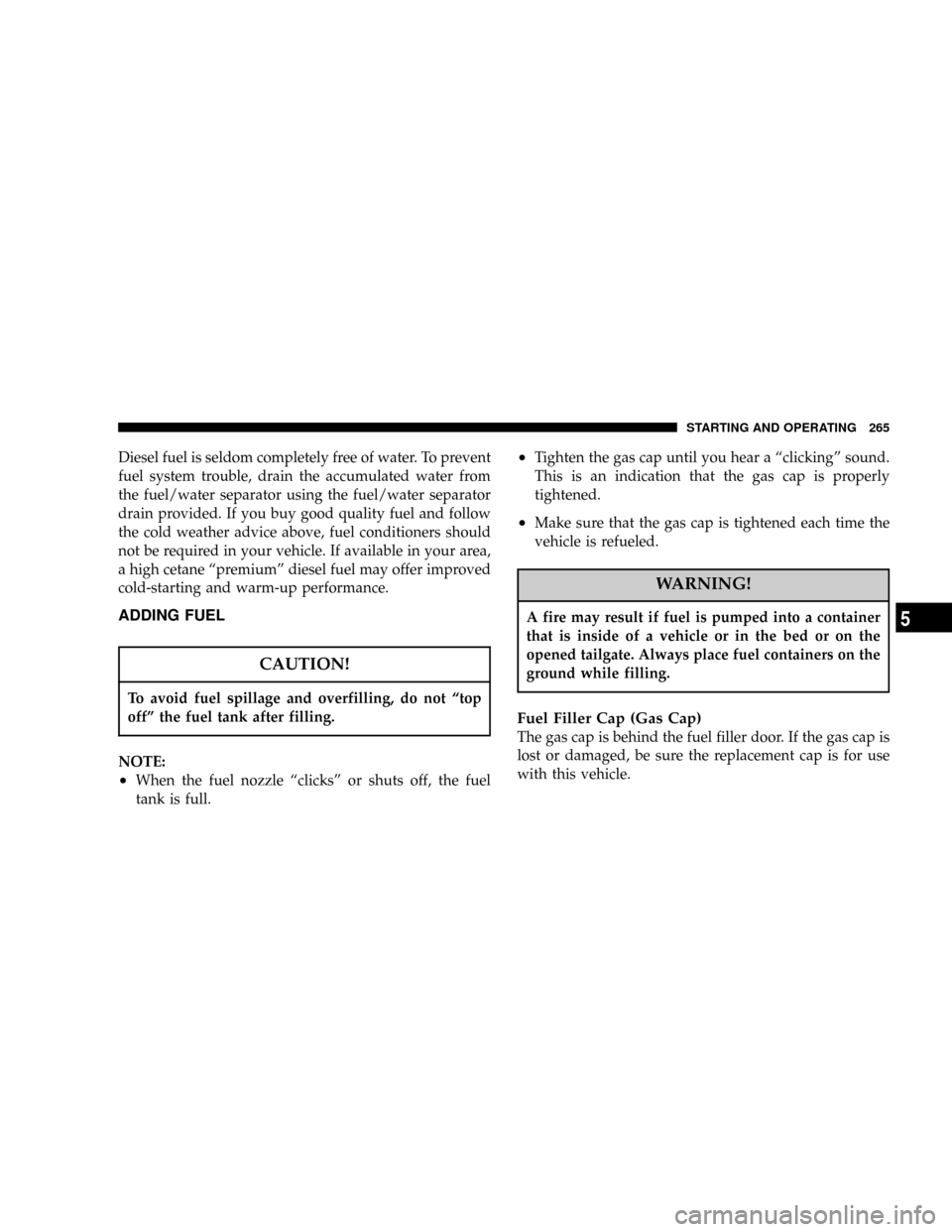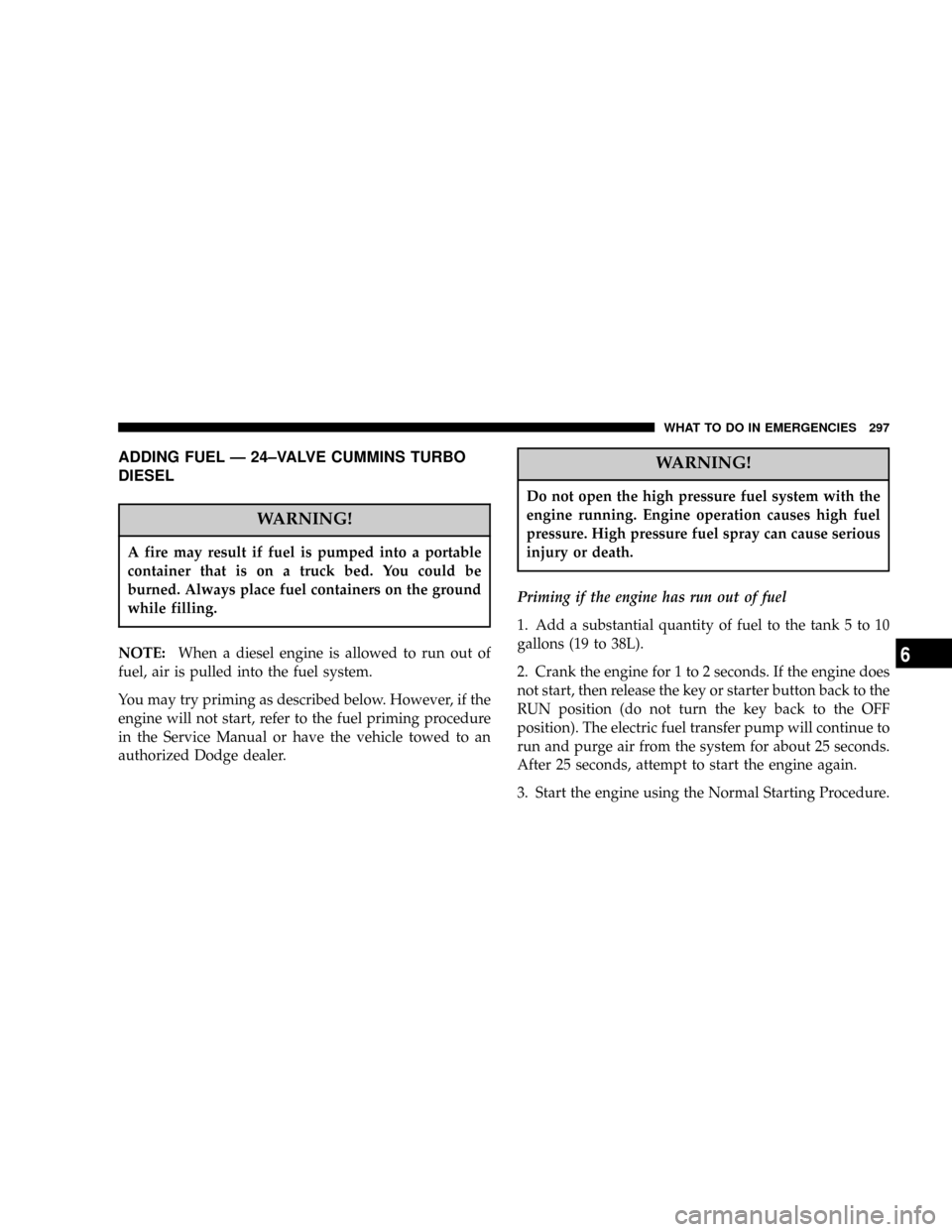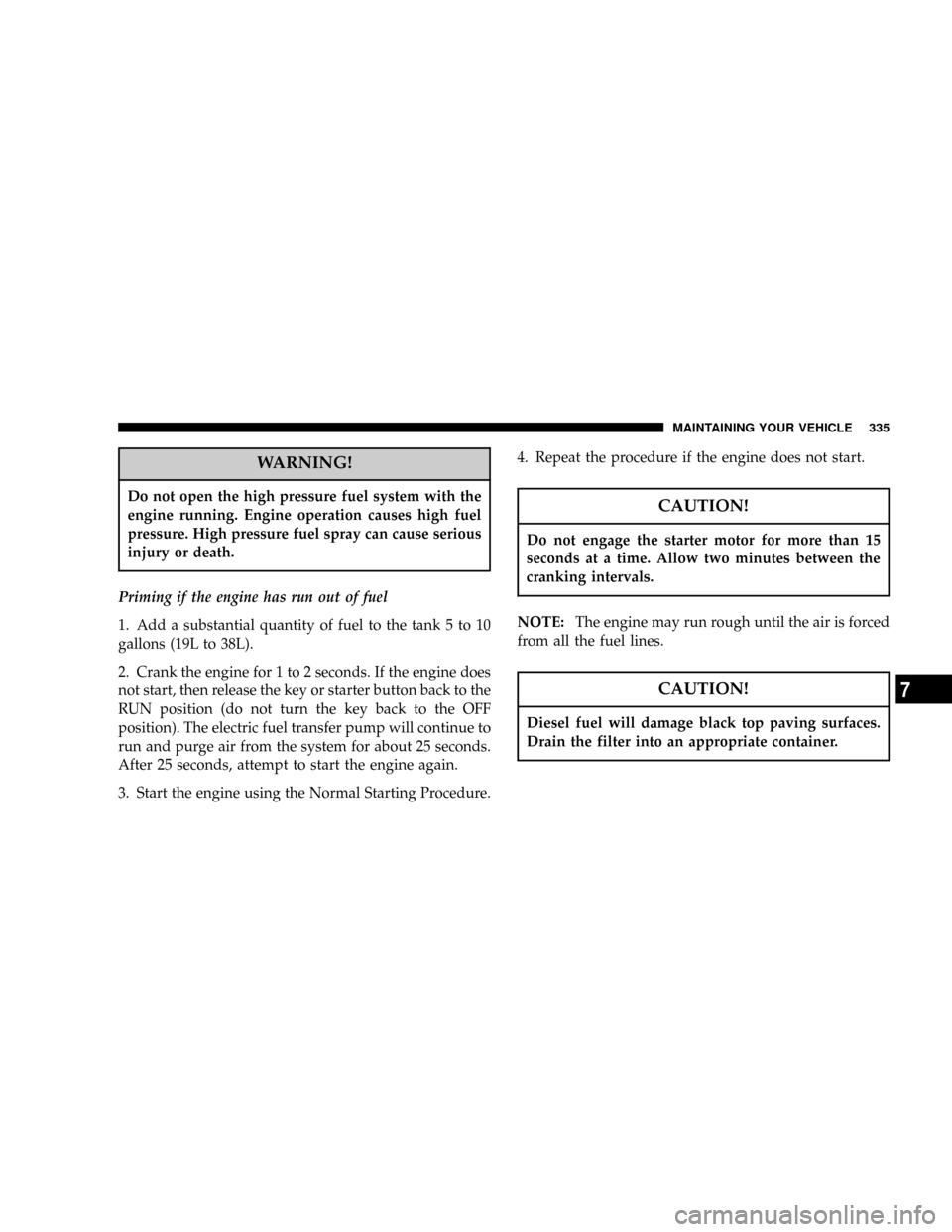Page 209 of 426

²Heat generated by the manifold heaters dissipates
rapidly in a cold engine. If more than two minutes
pass between the time the WAIT TO START light goes
OFF and the engine is started, recycle the manifold
heaters by turning the ignition OFF and then back ON.
²If the vehicle is driven and vehicle speed exceeds 18
mph (29 km) before the manifold heater post-heat
(after start) cycle is complete, the manifold heaters will
shut off.
²If the engine is started before the WAIT TO START
light turns off, the preheat cycle will turn off.
²If the engine is cranked for more than 10 seconds, the
post-heat cycle will turn off.
NOTE:Engine idle speed will automatically increase to
1000 rpm at low coolant temperatures to improve engine
warm-up.NOTE:When a diesel engine is allowed to run out of
fuel or the fuel gels at low temperatures, air is pulled into
the fuel system.
You may try priming as described below.
1. Add a substantial quantity of fuel to the tank (5 to 10
gallons) or eliminate the gelled fuel condition.
2. Crank the engine for 1 to 2 seconds. If the engine does
not start, then release the key or starter button back to the
RUN position (do not turn the key back to the OFF
position). The electric fuel transfer pump will continue to
run and purge air from the system for about 25 seconds.
After 25 seconds, attempt to start the engine again.
3. Start the engine using the Normal Starting Procedure.
4. Repeat the procedure if the engine does not start.
STARTING AND OPERATING 209
5
Page 265 of 426

Diesel fuel is seldom completely free of water. To prevent
fuel system trouble, drain the accumulated water from
the fuel/water separator using the fuel/water separator
drain provided. If you buy good quality fuel and follow
the cold weather advice above, fuel conditioners should
not be required in your vehicle. If available in your area,
a high cetane ªpremiumº diesel fuel may offer improved
cold-starting and warm-up performance.
ADDING FUEL
CAUTION!
To avoid fuel spillage and overfilling, do not ªtop
offº the fuel tank after filling.
NOTE:
²When the fuel nozzle ªclicksº or shuts off, the fuel
tank is full.
²Tighten the gas cap until you hear a ªclickingº sound.
This is an indication that the gas cap is properly
tightened.
²Make sure that the gas cap is tightened each time the
vehicle is refueled.
WARNING!
A fire may result if fuel is pumped into a container
that is inside of a vehicle or in the bed or on the
opened tailgate. Always place fuel containers on the
ground while filling.
Fuel Filler Cap (Gas Cap)
The gas cap is behind the fuel filler door. If the gas cap is
lost or damaged, be sure the replacement cap is for use
with this vehicle.
STARTING AND OPERATING 265
5
Page 297 of 426

ADDING FUEL Ð 24±VALVE CUMMINS TURBO
DIESEL
WARNING!
A fire may result if fuel is pumped into a portable
container that is on a truck bed. You could be
burned. Always place fuel containers on the ground
while filling.
NOTE:When a diesel engine is allowed to run out of
fuel, air is pulled into the fuel system.
You may try priming as described below. However, if the
engine will not start, refer to the fuel priming procedure
in the Service Manual or have the vehicle towed to an
authorized Dodge dealer.
WARNING!
Do not open the high pressure fuel system with the
engine running. Engine operation causes high fuel
pressure. High pressure fuel spray can cause serious
injury or death.
Priming if the engine has run out of fuel
1. Add a substantial quantity of fuel to the tank 5 to 10
gallons (19 to 38L).
2. Crank the engine for 1 to 2 seconds. If the engine does
not start, then release the key or starter button back to the
RUN position (do not turn the key back to the OFF
position). The electric fuel transfer pump will continue to
run and purge air from the system for about 25 seconds.
After 25 seconds, attempt to start the engine again.
3. Start the engine using the Normal Starting Procedure.
WHAT TO DO IN EMERGENCIES 297
6
Page 335 of 426

WARNING!
Do not open the high pressure fuel system with the
engine running. Engine operation causes high fuel
pressure. High pressure fuel spray can cause serious
injury or death.
Priming if the engine has run out of fuel
1. Add a substantial quantity of fuel to the tank 5 to 10
gallons (19L to 38L).
2. Crank the engine for 1 to 2 seconds. If the engine does
not start, then release the key or starter button back to the
RUN position (do not turn the key back to the OFF
position). The electric fuel transfer pump will continue to
run and purge air from the system for about 25 seconds.
After 25 seconds, attempt to start the engine again.
3. Start the engine using the Normal Starting Procedure.4. Repeat the procedure if the engine does not start.
CAUTION!
Do not engage the starter motor for more than 15
seconds at a time. Allow two minutes between the
cranking intervals.
NOTE:The engine may run rough until the air is forced
from all the fuel lines.
CAUTION!
Diesel fuel will damage black top paving surfaces.
Drain the filter into an appropriate container.
MAINTAINING YOUR VEHICLE 335
7
Page 388 of 426
Miles 3,750 7,500 11,250 15,000 18,750
(Kilometers) (6 000) (12 000) (18 000) (24 000) (30 000)
Change engine oil and engine oil filter. X X
Rotate tires. X X
Lubricate outer tie rod ends 2500/3500 (4X4) mod-
els only.XX
Inspect water pump weep hole for blockage. X
Replace fuel filter element. Clean the water in fuel
sensor.X
Change rear axle fluid.X
Change front axle fluid (4X4). X
Inspect brake linings.X
Inspect and adjust parking brake if necessary. X
388 SCHEDULE ªBº
8
M
A
I
N
T
E
N
A
N
C
E
S
C
H
E
D
U
L
E
S
Page 389 of 426
Miles 22,500 26,250 30,000 33,750 37,500
(Kilometers) (36 000) (42 000) (48 000) (54 000) (60 000)
Change engine oil and engine oil filter. X X X
Rotate tires. X X X
Lubricate outer tie rod ends 2500/3500 (4X4) mod-
els only.XXX
Inspect drive belt, replace as required. X
Inspect fan hub. X
Inspect damper. X
Inspect water pump weep hole for blockage. X
Replace fuel filter element. Clean the water in fuel
sensor.X
Change rear axle fluid. X
Change front axle fluid (4X4). X
Check transfer case fluid level (4X4). X
Drain and refill automatic transmission fluid. Re-
place filter and adjust bands.X
SCHEDULE ªBº 389
8
M
A
I
N
T
E
N
A
N
C
E
S
C
H
E
D
U
L
E
S
Page 390 of 426
Miles 41,250 45,000 48,750 52,500 56,250
(Kilometers) (66 000) (72 000) (78 000) (84 000) (90 000)
Change engine oil and engine oil filter. X X
Rotate tires. X X
Lubricate outer tie rod ends 2500/3500 (4X4) mod-
els only.XX
Inspect drive belt, replace as required. X
Inspect water pump weep hole for blockage. X
Replace fuel filter element. Clean the water in fuel
sensor.X
Inspect brake linings. X
Inspect and adjust parking brake if necessary. X
Change rear axle fluid. X
Change front axle fluid (4X4). X
390 SCHEDULE ªBº
8
M
A
I
N
T
E
N
A
N
C
E
S
C
H
E
D
U
L
E
S
Page 391 of 426
Miles 60,000 63,750 67,500 71,250 75,000
(Kilometers) (96 000) (102 000) (108 000) (114 000) (120 000)
Change engine oil and engine oil filter. X X X
Rotate tires. X X X
Lubricate outer tie rod ends 2500/3500 (4X4) models only. X X X
Inspect drive belt, replace as required. X
Inspect fan hub. X
Inspect damper. X
Inspect water pump weep hole for blockage. X X
Replace fuel filter element. Clean the water in fuel sensor. X X
Inspect front wheel bearings. X
Change rear axle fluid. X X
Change front axle fluid (4X4). X X
Inspect brake linings. X X
Inspect and adjust parking brake if necessary. X X
Drain and refill transfer case fluid (4X4). X
Drain and refill automatic transmission fluid. Replace fil-
ter and adjust bands.X
SCHEDULE ªBº 391
8
M
A
I
N
T
E
N
A
N
C
E
S
C
H
E
D
U
L
E
S